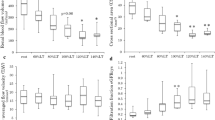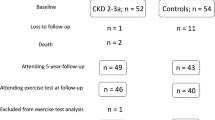Abstract
The aim of study was to assess the correlation between the changes in serum CK activity after a resistance exercise and renal function measured by glomerular filtration rate (eGFR). Twenty-nine trained women (32 ± 10 years; 157 ± 4 cm; 58.8 ± 6.4 kg) performed a resistance exercise session with 17 exercises with 3 × 12 repetitions in a circuit training fashion. Subjects provided blood samples prior to exercise session (PRE), and at 24, 48, and 72 h following exercise session for creatine kinase (CK) and creatinine. 24-Urine samples were collected before and 72 h after exercises. eGFR was obtained by the three most recommended methods (MDRD; MCQE; Cockcroft-Gault). After the exercise session, serum CK activity increase up 1.68 times (P < 0.01). Serum creatinine increased 25.5% (P = 0.0000) while urinary creatinine decreased on average 6.4% (P = 0.0422). eGFR decreased in all formulas: MDRD by 21.5%, MCQE by 14.2%, and C-G by 17% (all with P < 0.01). Ccr also decreased (−22.9%, P < 0.01). The index of correlation was significant for MDRD (r = −0.924; P < 0.01), C-G (r = −0.884; P < 0.01), and MQCE (r = −0.644; P < 0.05). In conclusion, we observed a significant negative correlation between CK activity and the eGFR indices of renal function.





Similar content being viewed by others
References
Skenderi KP, Kavouras SA, Anastasiou CA, Yiannakouris N, Matalas A (2006) Exertional rhabdomyolysis during a 246-km continuous running race. Med Sci Sports Exerc 38:1054–1057
Warren JD, Blumbergs PC, Thompson PD (2002) Rhabdomyolysis: a review. Muscle Nerve 25:332–347
Ohta T, Sakano T, Igarashi T, Itami N, Ogawa T (2004) Exercise-induced acute renal failure associated with renal hypouricemia: results of a questionnaire-based survey in Japan. Nephrol Dial Transplant 19:1447–1453
Chen TC, Hsieh SS (2001) Effects of a 7-day eccentric training period on muscle damage and inflammation. Med Sci Sports Exerc 33:1732–1738
Clarkson PM, Hoffman EP, Zambraski E, Gordish-Dressman H, Kearns A, Hubal M et al (2005) ACTN3 and MLCK genotype associations with exertional muscle damage. J Appl Physiol 99:564–569
Clarkson PM, Hubal MJ (2002) Exercise-induced muscle damage in humans. Am J Phys Med Rehabil 81:S52–S69
Nosaka K, Newton M, Sacco P (2002) Muscle damage and soreness after endurance exercise of the elbow flexors. Med Sci Sports Exerc 34:920–927
Stupka N, Lowther S, Chorneyko K, Bourgeois JM, Hogben C, Tarnopolsky MA (2000) Gender differences in muscle inflammation after eccentric exercise. J Appl Physiol 89:2325–2332
Clarkson PM, Kearns AK, Rouzier P, Rubin R, Thompson PD (2006) Serum creatine kinase levels and renal function measures in exertional muscle damage. Med Sci Sports Exerc 38:623–627
Myers GL, Miller WG, Coresh J, Fleming J, Greenberg N, Greene T et al (2006) Recommendations for improving serum creatinine measurement: a report from the Laboratory Working Group of the National Kidney Disease Education Program. Clin Chem 52:5–18
National Kidney Foundation - Kidney Disease Outcomes Quality Initiative (2000) Clinical practice guidelines for nutrition in chronic renal failure. Am J Kidney Dis 35:S1–S140
Sokoll LJ, Russell RM, Sadowski JA, Morrow FD (1994) Establishment of creatinine clearance reference values for older women. Clin Chem 40:2276–2281
Springer BL, Clarkson PM (2003) Two cases of exertional rhabdomyolysis precipitated by personal trainers. Med Sci Sports Exerc 35:1499–1502
NSCA Certification Commission (2008) Exercise technique manual for resistance training, 2nd edn. Human Kinetics, Champaign
Machado M, Willardson JM (2010) Short recovery augments the magnitude of muscle damage in high responders. Med Sci Sports Exerc 42:1370–1374
Borg G (1998) Borg’s perceived exertion and pain scales. Human Kinetics, Champaign
Banfi G, Del Fabbro M, Lippi G (2009) Serum creatinine concentration and creatinine-based estimation of glomerular filtration rate in athletes. Sports Med 39:331–337
Lippi G, Banfi G, Salvagno GL, Montagnana M, Franchini M, Guidi GC (2008) Comparison of creatinine-based estimations of glomerular filtration rate in endurance athletes at rest. Clin Chem Lab Med 46:235–239
Heled Y, Bloom MS, Wu TJ, Stephens Q, Deuster PA (2007) CK-MM and ACE genotypes and physiological prediction of the creatine kinase response to exercise. J Appl Physiol 103:504–510
Banfi G, Melegati G, Valentini P (2007) Effects of cold-water immersion of legs after training session on serum creatine kinase concentrations in rugby players. Br J Sports Med 41:339
Gill ND, Beaven CM, Cook C (2006) Effectiveness of post-match recovery strategies in rugby players. Br J Sports Med 40:260–263
Magalhães J, Rebelo A, Oliveira E, Silva JR, Marques F, Ascensão A (2010) Impact of Loughborough Intermittent Shuttle Test versus soccer match on physiological, biochemical and neuromuscular parameters. Eur J Appl Physiol 108:39–48
Milic R, Banfi G, Del Fabbro M, Dopsaj M (2011) Serum creatinine concentrations in male and female elite swimmers. Correlation with body mass index and evaluation of estimated glomerular filtration rate. Clin Chem Lab Med 49:285–289
Clarkson PM, Nosaka K, Braun B (1992) Muscle function after exercise-induced muscle damage and rapid adaptation. Med Sci Sports Exerc 24:512–520
Soni SS, Cruz D, Bobek I, Chionh CY, Nalesso F et al (2010) NGAL: a biomarker of acute kidney injury and other systemic conditions. Int Urol Nephrol 42:141–150
Acknowledgments
For Priscilla Clarkson for helpful comments on the manuscript. For Felipe Sampaio-Jorge for your help in statistics.
Author information
Authors and Affiliations
Corresponding author
Rights and permissions
About this article
Cite this article
Machado, M., Zini, E.N., Valadão, S.D. et al. Relationship of glomerular filtration rate and serum CK activity after resistance exercise in women. Int Urol Nephrol 44, 515–521 (2012). https://doi.org/10.1007/s11255-011-9963-4
Received:
Accepted:
Published:
Issue Date:
DOI: https://doi.org/10.1007/s11255-011-9963-4




